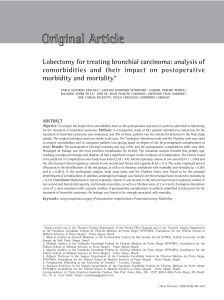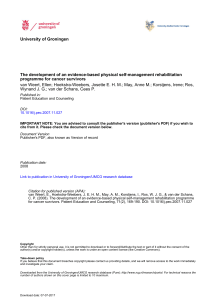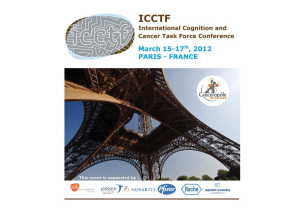Effects of Comorbid Disease on Pre-treatment Neurobehavioral Functioning. Sunita K. Patel, PhD
publicité
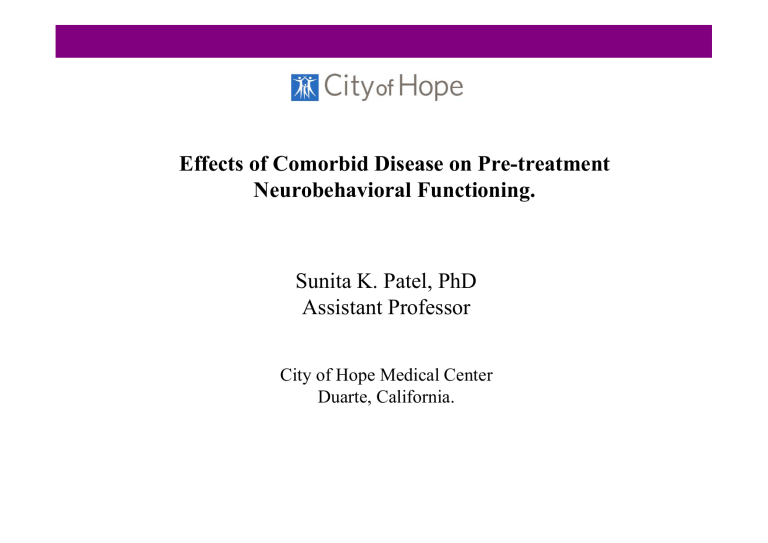
Effects of Comorbid Disease on Pre-treatment Neurobehavioral Functioning. Sunita K. Patel, PhD Assistant Professor City of Hope Medical Center D arte California Duarte, California. Pre-Chemotherapy e C e o e apy Cognitive Cog ve Functioning u c o g Neurocognitive dysfunction in survivors of breast cancer is primarily attributed to the effects of chemotherapy and/or hormonal therapy. However, more recent studies suggest these symptoms are present even prior to adjuvant treatments. Initially reported in the first prospective trial that assessed pts prior to chemo rather than only after treatment (Wefel et al., Cancer, 2004). In this study of breast cancer pts, 33% showed neurocognitive deficits prior to starting chemo. The presence off low Th l scores in i about b t 30% att pre-chemo h has h since i been b replicated with larger N = 101 (Hermelink et al., Cancer 2007). The reasons for cognitive problems in cancer patients prior to treatment are not known. Possible mechanisms underlying effects for both prior treatment, and for the dysfunction observed following treatment, have been postulated. Proposed Mechanisms for Cognitive Changes Changes. Blood-brain Blood brain barrier integrity Genetic susceptibility Changes in cognition, and brain structure and function Oestrogen or testosterone reduction Ahl andd S Ahles Saykin, ki Nature N t Reviews R i Cancer, C 7 2007 7, DNA damage and telomere length Cytokine deregulation Study Objective and Background We hypothesized that comorbid health status at cancer diagnosis is associated with lowered neurocognitive and behavioral functioning prior to initiation of cancer treatment. This was based on the literature linking cognitive and behavioral dysfunction with various non-cancer health/disease conditions. Type 1 and Type 2 diabetes have been associated with neurocognitive compromise (Review article: Kodl et al., 2008). There is an increased incidence of dementia in pts with Type 2 (Cukierman et al., al 2005) Elevated blood pressure is a risk factor for vascular dementia and decline of cognitive function in middle age and older patients (Papademetriou, 2005). Treating HTN lessens the cognitive complications “only 34% of hypertensive Americans have their hypertension under control, despite widespread treatment”(Papademetriou, 2005). Methods Used data from an ongoing study tracking various outcomes in newly diagnosed breast cancer pts. across two years. In the larger study, post-menopausal women newly diagnosed with breast cancer are seen for neurobehavioral assessment prior to any treatment, including g surgery. g y We used the baseline assessment data to evaluate the impact of a comorbid bid hhealth lth condition diti on neurobehavioral b h i l ffunctioning ti i prior i to t any treatment. Results are based on 176 post-menopausal breast cancer patients for whom we have pre-treatment data. Eligibility Criteria for the Larger Study Newly y diagnosed g breast cancer,, stages g 0-III ((excludes stage g IV)) Post-menopausal status as defined by self-report of no menstruation for 12 months or longer No previous history of cancer diagnosis in the past 5 years. No neurological or severe psychiatric disorders. No use off substances N b kknown to bbe active i in i the h CNS (e.g. ( narcotics, i anti-emetics,) within 2 weeks of baseline data collection. Ability to read and/or comprehend English at a 3rd grade reading level No history of infection within past 2 weeks and no fever at evaluation time. Study Measures Neurocognitive Objective Obj i neurocognitive tests administered by a t i d examiner. trained i Self-report Brief Symptom Inventory (BSI; Derogatis, 2004). Behavior Rating Inventory of Executive Functioning (BRIEF; Roth et al., 2005) Tests selected from recommended battery to use in research with cancer patients (Vardy et al.)) MOS-SF36 Physical Health and S i l Support Social S scales l (Ware ( et al.1992) l 1992) Functional Activities Questionnaire ((FAQ; Pfeffer 1982)) Blood draw for biomarkers. Detailed review of patient’s medical records. Fatigue Symptom Inventory (FSI; Moffitt Cancer Center, 1998) Other Demographic/Lifestyle Q Charlson Comorbidity Index scale (Extermann 2000). Charlson C a so Co Comorbidity o b d y Index de (Extermann, ( e a , 2000) 000) Charlson Comorbidity Index Assigns point value to conditions depending on relative risk of death. Overall O ll score is i the h sum off all ll the h points assigned to a patient’s comorbid health conditions. Co-morbid Point Assignments Assigned Point Value Condition • • • 1 • • • • • • The original Charlson index did not assign any points to Hypertension. • • • Diabetes (with end organ damage) Hemiplegia Moderate or severe renal disease Any solid tumor (non-metastatic) Leukemia Lymphoma 3 • Moderate or severe liver disease 6 • Metastatic solid tumor AIDS • The augmented Charlson Index assigns 1 point to HTN (Braithwaite et al., l 2009). 2009) For the current presentation, we used the HTN augmented Charlson Index History of myocardial infarction Congestive heart failure Peripheral p vascular disease Cerebrovascular disease Dementia Chronic pulmonary disease Connective tissue disease Ul disease Ulcer di Mild liver disease Diabetes (without complications) Hypertension • • 2 • • • Sample Characteristics (N = 176) Demographic Characteristics Age Cancer Characteristics Mean =60.59, =60 59 SD =7.1, =7 1 Range =45-84yrs =45 84yrs 41-50 51-60 61 70 61-70 71-80 81-90 Education < High school g school > High Income < $45,000 $45,001 $45 001 - $75,000 $75 000 > $75,001 7.4% 43.3% 40 3% 40.3% 8.0% 1.2% 27.3% 68.8% 30.7% 16 5% 16.5% 36.3% Race White/Caucasian Other 65% 35% Cancer Stage O I II III Estrogen Hormone Receptor Status Positive Negative 72.2% 18.8% Progesterone Hormone Receptor Status Positive Negative 12.5% 12 5% 41.5% 26.2% 9 1% 9.1% 63.1% 27.8% Body Mass Index (BMI) Underweight (<18.5) Normal (18.5-24.9) Overweight (25-30) Obese (>30) 0.6% 30.1% 29.5% 34.1% Methods The validated Charlson Comorbidity Index was calculated for each patient using medical records to represent baseline comorbid disease conditions. Statistical analyses were conducted using the presence versus absence of a qqualifying y g comorbid condition as the independent p variable, and neurobehavioral scores as dependent variables. A ttotal t l off 91(52%) women in i our sample l had h d att least l t one qualifying lif i comorbidity, while 85 women (48%) did not have a comorbid health condition. The comorbid and No comorbid groups were similar in education, social support, support and cancer stage. stage The mean age in the comorbid group was 62 years vs. 59 years. Comorbidityy Characteristics of the Studyy Sample p Comorbidity in study sample Cardiovascular Dysfunction Peripheral Vascular Disease Cerebrovascular Disease D Dementia ti Chronic Pulmonary Disease Connective Tissue Disease Ulcer Disease Mild Liver Disease Diabetes Hemiplegia Moderate or Severe Renal Disease Lymphoma Moderate or Severe Liver Disease AIDS Hypertension Pervious Cancer N % 8 0 0 0 18 4 6 8 19 0 1 1 1 0 64 5 4.5 0 0 0 10.2 2.3 3.4 4.5 10 8 10.8 0 0.6 0.6 0.6 0 36.0 2.8 Cognitive Measures Verbal Learning g and memoryy assessed by: y Hopkins Verbal Learning Test (HVLT; Brandt, 1991). Attention/working memory assessed by: WAIS-IV (Pearson, 2008). Digit Span Sequencing subtests Executive functioning assessed by: D-KEFS D KEFS subtests bt t (Pearson, (P 2001) Trails 4 Switching test Letter Fluency Category Switching Color Word Inhibition & Inhibition Switching Behavior Rating Inventory of Executive Functioning (Roth et al., 2005) Cognitive Measures (continued) Processing Speed assessed by: WAIS-IV Processing Speed Index (Pearson, 2008) Delis-Kaplan Executive Functioning System (D-KEFS; Pearson, 2001) Trail Making Test 2 Color Word Naming Color C l Word W d Reading R di Fine motor coordination and speed is assessed by: Grooved Peg Board (Matthews & Klove, 1964) Estimate of pre-morbid IQ is assessed by: Wide Range Achievement Test-IV (WRAT4; Wilkinson & Robertson 2006) R di subtest. Reading bt t ANCOVA Results: Significant Differences on Processing Speed (controlled for age and education) P Processing i Speed S d 58 55 52 55.32 54 96 54.96 51.26 50.75 49.75 49 No Comorbidity 46 44.47 Comorbidity 43 40 WAIS Processing Speed DKEFS Color Word Reading Grooved Pegboard F(1, 142) = 9.30 F(1, 155) = 3.82 F(1, 122) = 6.81 p = .003 p = .05 p = .01 Performance scores presented in T-score measurement (M = 50, SD = 10) ANCOVA results: Significant Differences on Executive Functioning (controlled for age and education) Executive Functioning 12 11.5 11 10.65 10.33 10.5 10 11 12 11.12 11 09 11.09 10.21 9.35 No Comorbidity 9.5 Comorbidity 9 8.5 8 Trails 4 F(1, 149) = 6.33 p = .01 Inhibition Inhibition Switching F(1, 154) = 4.23 F(1, 154) = 4.26 p = .04 p = .041 Performance scores presented in scaled score measurement (M = 10, SD = 3) ANCOVA Si ANCOVA: Sig Diff Differences on S Self-report lf t off Cognitive C iti Dysfunction. D f ti BRIEF 60 58 56 64 56.64 56.29 55.26 56 54 52 50 50.07 49.48 49.09 No Comorbidity Comorbidity 48 46 44 Global Executive Metacognition F(1, 155) = 20.63 F(1, 155) = 16.52 p < .001 p < .001 Behavioral Regulation F(1, 157) = 15.10 p < .001 T-score measurement (M = 50, SD = 10) ANCOVA R Results: lt Si Sig. Diff Differences on B Brief i f Symptom S t IInventory t Brief Symptom Inventory 58 55.87 56 54.05 54 52.78 52.47 52 50 49.77 No Comorbidity 49.92 Comorbidity 48 46 BSI Somatic F(1, 158) = 5.73 p = .02 BSI Depression BSI Anxiety F(1, 158) = 8.48 F(1, 158) = 2.72 p = .004 p = .10 ANCOVA Significant ANCOVA: Si ifi t Differences Diff iin Self-report S lf t off F Fatigue ti Fatigue Symptom Inventory 24 20.31 21 18 15 13.73 12 No Comorbidity 9 Comorbidity 6 3 0 FSI Disruption Index F(1, 137) = 12.34 p = .001 ANCOVA Sig ANCOVA: Si Differences Diff iin S Self-report lf t off F Functional ti l Status. St t Functional Activities 3 2.55 2.5 2 1.5 No Comorbidity 1 0.61 Comorbidity 0.5 0 Functional Activities F(1, 161) = 8.78 p = .004 ANCOVA Sig ANCOVA: Si Differences Diff iin S Self-report lf t off Ph Physical i l Health. H lth SF36 Physical Health Scale 93 87 73 87.73 89 85 81 75 77 No Comorbidity Comorbidity 73 69 65 Physical Health F(1, 129) = 9.65 p = .002 Mean in the normative sample = 84.42, SD = 23.3 Sig. g Differences in Interleukin logg 6 in a subsample p of 120 p patients (controlled for age and education). IL6 0.4 0.31 0.35 0.3 0 25 0.25 0.2 0.16 No Comorbidity 0.15 Comorbidity y 0.1 0.05 0 IL6 F(1, 114) = 9.15 p = .003 N sig. No i diff differences iin IL6 when h BMI held h ld as a covariate. i t No comorbidity group: Comorbidity group: BMI Mean = 26.97 (SD: 5.17) BMI Mean = 30.85 30 85 (SD: 6 6.85) 85) IL6 0.4 0.35 0.29 03 0.3 0.25 0.2 0 15 0.15 0.14 No Comorbidity y Comorbidity 0.1 0.05 0 IL6 F(1 110) = 2 F(1, 2.74 74 p = .10 Summary of findings Post-menopausal breast cancer patients with health comorbidies have g pperformance even pprior to any y cancer treatment lowered neurocognitive compared to those without a comorbid health condition. Differences found on measures of executive functioning and processing speed but not on tests of verbal learning and memory speed, memory, working memory, memory language, or estimated intelligence. Breast cancer patients with at least one health comorbidity also selfreported d greater behavioral b h i l symptoms/dysfunction. /d f i The majority of these differences are not of a magnitude to be viewed as cclinically ca y significant s g ca since s ce mean ea scores sco es for o both bo groups g oups we weree mostly os y w within normal limits. However, these findings do suggest comorbid health conditions impact neurobehavioral symptoms and should be methodologically considered in cognition-related cancer research. Certainly, the contribution of comorbidity in predicting treatment-related changes h iin cancer patients i should h ld bbe considered. id d Acknowledgments Collaborators & Research Staff: Arpine Davtyan, Ellis Beier, Beier Krystle Barrera, Andrew Wong, Adrienne Meier Meier, Lennie Wong, Arti Hurria Eli b h Breen Elizabeth B Michael Irwin Smita Bhatia. Grant Funding: NCI R21CA 131878 ACS RSG-12-049-01 CPPB

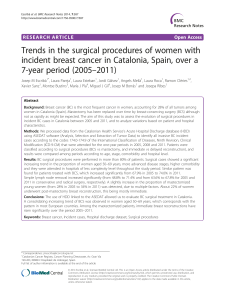
![[www.ijcem.com]](http://s1.studylibfr.com/store/data/009485480_1-913c5178e1ea985a05f6c76e5f3c86cf-300x300.png)
